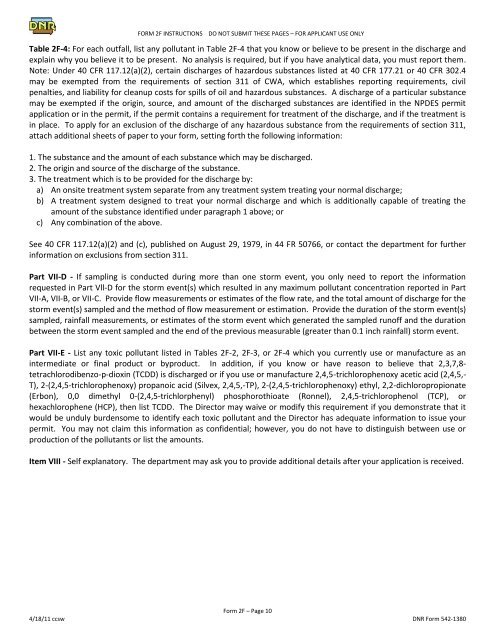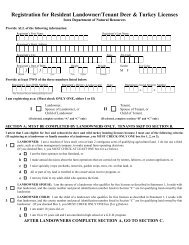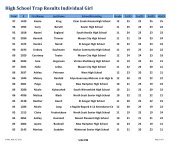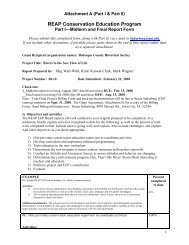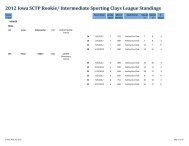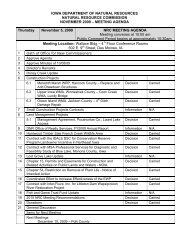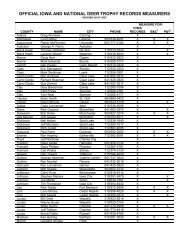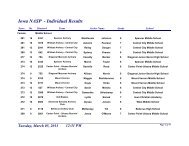iowa department of natural resources npdes permit application
iowa department of natural resources npdes permit application
iowa department of natural resources npdes permit application
Create successful ePaper yourself
Turn your PDF publications into a flip-book with our unique Google optimized e-Paper software.
FORM 2F INSTRUCTIONS DO NOT SUBMIT THESE PAGES – FOR APPLICANT USE ONLY<br />
Table 2F-4: For each outfall, list any pollutant in Table 2F-4 that you know or believe to be present in the discharge and<br />
explain why you believe it to be present. No analysis is required, but if you have analytical data, you must report them.<br />
Note: Under 40 CFR 117.12(a)(2), certain discharges <strong>of</strong> hazardous substances listed at 40 CFR 177.21 or 40 CFR 302.4<br />
may be exempted from the requirements <strong>of</strong> section 311 <strong>of</strong> CWA, which establishes reporting requirements, civil<br />
penalties, and liability for cleanup costs for spills <strong>of</strong> oil and hazardous substances. A discharge <strong>of</strong> a particular substance<br />
may be exempted if the origin, source, and amount <strong>of</strong> the discharged substances are identified in the NPDES <strong>permit</strong><br />
<strong>application</strong> or in the <strong>permit</strong>, if the <strong>permit</strong> contains a requirement for treatment <strong>of</strong> the discharge, and if the treatment is<br />
in place. To apply for an exclusion <strong>of</strong> the discharge <strong>of</strong> any hazardous substance from the requirements <strong>of</strong> section 311,<br />
attach additional sheets <strong>of</strong> paper to your form, setting forth the following information:<br />
1. The substance and the amount <strong>of</strong> each substance which may be discharged.<br />
2. The origin and source <strong>of</strong> the discharge <strong>of</strong> the substance.<br />
3. The treatment which is to be provided for the discharge by:<br />
a) An onsite treatment system separate from any treatment system treating your normal discharge;<br />
b) A treatment system designed to treat your normal discharge and which is additionally capable <strong>of</strong> treating the<br />
amount <strong>of</strong> the substance identified under paragraph 1 above; or<br />
c) Any combination <strong>of</strong> the above.<br />
See 40 CFR 117.12(a)(2) and (c), published on August 29, 1979, in 44 FR 50766, or contact the <strong>department</strong> for further<br />
information on exclusions from section 311.<br />
Part VII-D - If sampling is conducted during more than one storm event, you only need to report the information<br />
requested in Part Vll-D for the storm event(s) which resulted in any maximum pollutant concentration reported in Part<br />
VII-A, VII-B, or VII-C. Provide flow measurements or estimates <strong>of</strong> the flow rate, and the total amount <strong>of</strong> discharge for the<br />
storm event(s) sampled and the method <strong>of</strong> flow measurement or estimation. Provide the duration <strong>of</strong> the storm event(s)<br />
sampled, rainfall measurements, or estimates <strong>of</strong> the storm event which generated the sampled run<strong>of</strong>f and the duration<br />
between the storm event sampled and the end <strong>of</strong> the previous measurable (greater than 0.1 inch rainfall) storm event.<br />
Part VII-E - List any toxic pollutant listed in Tables 2F-2, 2F-3, or 2F-4 which you currently use or manufacture as an<br />
intermediate or final product or byproduct. In addition, if you know or have reason to believe that 2,3,7,8-<br />
tetrachlorodibenzo-p-dioxin (TCDD) is discharged or if you use or manufacture 2,4,5-trichlorophenoxy acetic acid (2,4,5,-<br />
T), 2-(2,4,5-trichlorophenoxy) propanoic acid (Silvex, 2,4,5,-TP), 2-(2,4,5-trichlorophenoxy) ethyl, 2,2-dichloropropionate<br />
(Erbon), 0,0 dimethyl 0-(2,4,5-trichlorphenyl) phosphorothioate (Ronnel), 2,4,5-trichlorophenol (TCP), or<br />
hexachlorophene (HCP), then list TCDD. The Director may waive or modify this requirement if you demonstrate that it<br />
would be unduly burdensome to identify each toxic pollutant and the Director has adequate information to issue your<br />
<strong>permit</strong>. You may not claim this information as confidential; however, you do not have to distinguish between use or<br />
production <strong>of</strong> the pollutants or list the amounts.<br />
Item VIII - Self explanatory. The <strong>department</strong> may ask you to provide additional details after your <strong>application</strong> is received.<br />
Form 2F – Page 10<br />
4/18/11 ccsw DNR Form 542-1380


